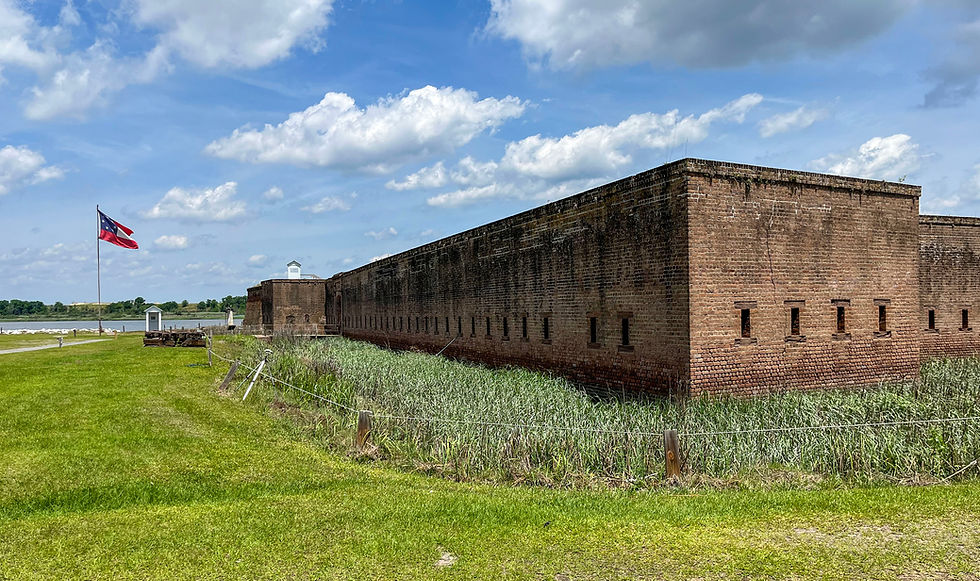Antietam National Battlefield
- Tim Murphy

- Sep 28, 2017
- 8 min read
Updated: Apr 24, 2021
A dark shadow was cast over Sharpsburg, Maryland and Antietam Creek on September 17, 1862, when the armies of North and South clashed in what would later be recognized as the bloodiest one-day battle of the Civil War. Over 100,000 men engaged in this battle, which resulted in more casualties than the Revolutionary War, War of 1812, and Mexican-American War combined! In total, nearly 19,000 men were wounded and 4,000 dead. It's hard to imagine that 155 years ago, these fields were drenched in blood and the screams of the wounded and dying filled the air. Today, there is only a melancholy silence that covers the battlefield, a silence that echoes to the brave men who departed on that day.

The Battle of Antietam was the apex of the South's Maryland Campaign of 1862. Through August of that year, the tide had turned considerably in the Confederacy's direction. Lee's Army had recently defeated the Union at 2nd Manassas and Confederate armies in the western front were showing great success. Confederate President Jefferson Davis and Lee both agreed that they should go on the offensive and invade the North. The Confederate Army split and engaged Federal troops in two places to begin their campaign: Harper's Ferry, WV, and South Mountain (MD). While unsuccessful at South Mountain, 13,000 Union troops surrendered to General Stonewall Jackson at Harper's Ferry. This victory prompted Lee to dispatch Special Order 191 to reassemble his troops with Jackson's at Sharpsburg.
While these maneuvers were supposed to be secret, a copy of the orders somehow got lost. They were found by members of the 27th Indiana (Union) wrapped around two cigars. This vital information was handed over to General McClellan, who then had a precise idea of where the Confederate Army would be and when. McClellan marched his troops west toward Antietam Creek on September 16, intending to engage the enemy in a battle to end all battles.

At 5:30 am, September 17, with his troops in position and Confederate line in sight, McClellan signaled to attack. Members of the First Corps under the command of Union Gen. Joseph Hooker advanced through the corn fields near the North Woods towards Dunker Church. Heavy musket fire opened on both sides, causing tremendous casualties to commence the battle.
Stonewall Jackson, positioned on Nicodemus Heights, was in charge of the Confederate Army in this stage of the battle. A career artilleryman, he had strategically placed cannons along the ridge in anticipation for a defensive engagement. As the Confederates pulled back, the Union gave Jackson exactly what he wanted, a full-frontal assault. Seeing the oncoming wave of blue, Confederate artillery opened fire. The result was disastrous for the Union troops exposed in the fields. The Union retreated and the Confederates gave chase, but were ultimately pushed back to their original positions.
Across the cornfields in the East Woods, another large engagement was taking place. Members of the First Corps battled General Alexander Lawton's Confederate divison of 2500 men throughout the morning. While the Confederates held a vulnerable position in the open fields adjacent to the woods, they managed to withstand the repeated attacks of the First Corps. It wasn't until General Joseph King Ferro Mansfield and the Union Twelfth Corps arrived to assist the First that the Confederates were driven from this area. However, as Mansfield tried to organize his troops, he was struck in the chest and mortally wounded. In their success, the Union lost a valuable leader. On the Confederate side, nearly half of Lawton's men were listed as casualties. Of the 25,000 soldiers who fought in the cornfields, 8,200 were listed as casualties within the first four hours of fighting (nearly equal on both sides).
At 9:15 am, the Union Second Corps, under the command of General Edwin Sumner, crossed Antietam Creek to engage the enemy in the West Woods. Remnants of General Jackson and Hood's troops retreated here after the onslaught in the cornfield. Believing this to be an opportunity to land a punishing blow to the hurting Confederates, a division of 5,000 men advanced into the woods. However, unbeknownst to them, Confederate General Lafayette McLaws arrived from Harper's Ferry with his troops moments before to support Jackson. Upon entering the woods, the Union infantry was annihilated by Confederate artillery and musket fire. Over 2,200 casualties were suffered on the Union side within twenty minutes.

At 9:30 am, the battle shifted from the cornfield and wooded areas to the Sunken Road, a well-worn wagon trail that Confederate General D.H. Hill used as a rifle pit stronghold. General William M. French led two division of the Union Second Corps across farm fields to the Confederate position. Although his force was 5,000 strong, many of French's troops had never been in battle. This inexperience caused confusion and massive casualties on their side. It was only after General Israel Richardson and 4,000 reinforcements arrived that the Union started to make progress on the Sunken Road. The majority of the fighting was from point-blank range, causing insurmountable losses. The Union tide eventually overtook the road, but at the cost of 5,500 men in total, giving this location the nickname "Bloody Lane."
Further South, about 500 Confederates under the command of General Robert Toombs lined Antietam Creek near Rohrbach Bridge (later renamed Burnside Bridge). General Ambrose Burnside and Union 9th Corps sought to cross the bridge and capture the Confederate positions on the bluffs. At 9:30 am, the first of three Union assaults on the Confederate line began. This and the second attack were repulsed with ease; however, after three hours of fighting, Confederate troops ran low on ammunition, forcing them to withdraw on the third and final surge from the Union Army.
The withdrawal of the Confederate Army from the bluff allowed 10,000 Federal troops under General Burnside's command to cross Antietam Creek. They formed a mile-long battle line that marched across the landscape. Up ahead, 2,500 Confederate Infantry and some forty cannons awaited their arrival. The Union surged against the smaller Confederate force in the face of heavy musket and artillery fire. But just as the Union was about to take the high ground, Confederate General A.P. Hill and his men, who had just marched 17 miles from Harper's Ferry, arrived to support Lee. These reinforcements kept the Union at bay until nightfall when the shooting stopped.
After twelve hours of fighting, 23,000 casualties covered the battlefield, over 4,000 of them dead. General Lee reassessed the situation and decided to delay the Northern invasion. Early the next morning, Lee ordered his troops back across the Potomac River into Virginia.

With so many dead scattered across the battlefield, Union troops and civilians faced the daunting task of burying them all. They hastily dug shallow mass graves that eroded away in the months to come. The remains of dead soldiers were seen by members of Lee's Army as they marched toward Gettysburg in June 1863. In 1864, legislators approved construction for Antietam National Cemetery and three years later it was completed. The remains of Federal troops were relocated to this site, while Confederate remains were left behind. Eventually, identified remains were sent back south with the rest buried in local cemeteries.
The effects of war certainly took shape on this small farming community. Sharpsburg was a town of only 1,300 people (mostly of German descent) before the armies clashed. In the immediate aftermath, over 80,000 Union troops occupied the town. Churches and barns were commandeered as field hospitals, resources were used up rapidly, and any sense of normal living was disrupted.
The first stop on the tour was the Dunker Church. Built in 1852, this church served the local German Baptist community known as the "Dunkers"--a modest and simple group who practiced full immersion baptism (hence the name). During the battle, this was the site of some of the heaviest artillery fighting. The church was left riddled by bullet holes and artillery shells, but still standing nonetheless. The original building collapsed in 1921 after a windstorm and was rebuilt in 1962.
I arrived at the Poffenberger Farm, the second stop of the tour. It was here that Clara Barton did much of her humanitarian work. She nursed the wounded and dying at field hospitals, prepared meals, and delivered supplies to the troops. After the war, Barton founded 'Friends of the Missing Men of the United States Army,' which was dedicated to finding the grave sites of missing US soldiers. Barton would later establish the first American Red Cross in 1881.
Directly across from the farm is the North Woods, the area when the First and Twelfth Union Corps organized their troops for battle. Further down the road are the East Woods and Cornfield, sites of some of the bloodiest fighting of the battle.

The fifth stop on the driving tour is Philadelphia Brigade Park. The Philadelphia Brigade was part of the Second Corps of the Army of the Potomac. They were detached to fight in the West Woods, a Confederate stronghold throughout the battle. This brigade lost 550 men within the failed twenty-minute attack. In 1896, the Philadelphia Brigade Association bought this section of land and dedicated a 75-foot obelisk to commemorate their fallen comrades.
Stop number six is the Mumma Farm and Cemetery. The Mumma farmhouse was burned by Confederates before the battle began, fearing it would be a vantage point for Union sharpshooters. It was the only deliberate act of destruction to civilian property over the course of the battle. The Mummas returned and rebuilt their homestead in 1863, but were not compensated by the government after the war because the destruction was not caused by Federal troops. The cemetery on this property dates back to the late 18th Century, but was deeded to be enlarged by the Mummas for members of the Dunker Church in 1870.
My next stop was at the Sunken Road. It's a very somber place to visit, especially since many of the famous aftermath photos of the battle are staged here. At the end of the road is the War Department Observation Tower, which offers a stunning 360-view of the battlefield.

Crossing Boonsboro Turnpike, I passed the Sherrick Farmhouse and arrived at Burnside Bridge. The bridge was built in 1836 and witnessed some intense fighting during the battle. William McKinley, the 24th President of the United States, was a Sergeant with the 23rd Ohio and fought with his regiment on this bridge. The bridge has been preserved quite well, considering it was active up till 1966. Today, pedestrians can walk across and visit Union monuments and positions on the opposite side of Antietam Creek. You can also visit the site where members of the 2nd and 20th Georgia regiments were positioned up on the bluff.
The final stop on the tour was the Antietam National Cemetery. Here, over 4700 Union troops are interred, a third of which are unknown. An additional 500 servicemen and women from later wars are also laid to rest here.
Just east of the battlefield grounds is the Pry House, which served as General McClellan's headquarters during the battle and the months afterward. Tens of thousands of soldiers camped on their property, many of whom were wounded from combat. Field hospitals were established in the main house and barn to tend to the injured and sick. In October 1863, President Lincoln visited the Pry House to discuss war strategy with McClellan and console the wounded. Today, the Pry House is a field hospital museum (unfortunately it was closed when I visited).
Antietam is an incredible place to visit. The battlegrounds are well-maintained and the tour route is easy to follow. And if you don't want to drive the whole way, there are numerous hiking trails across the map that'll take you by some the battle's most important locations. Additionally, this is one of the most well-documented engagements of the Civil War, so there is no shortage of information to be learned! I encourage you all to make the trip to Sharpsburg and visit this hallowed ground.


































